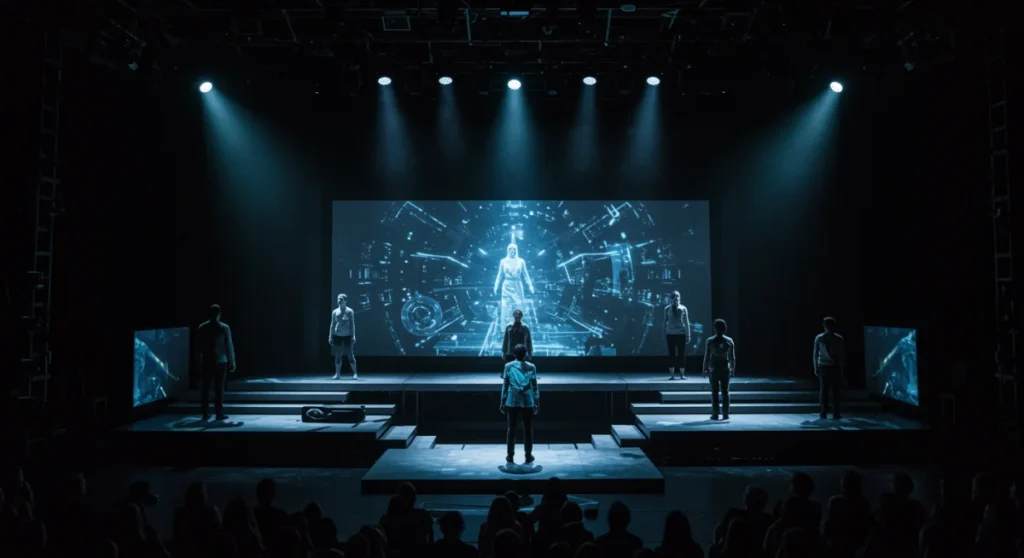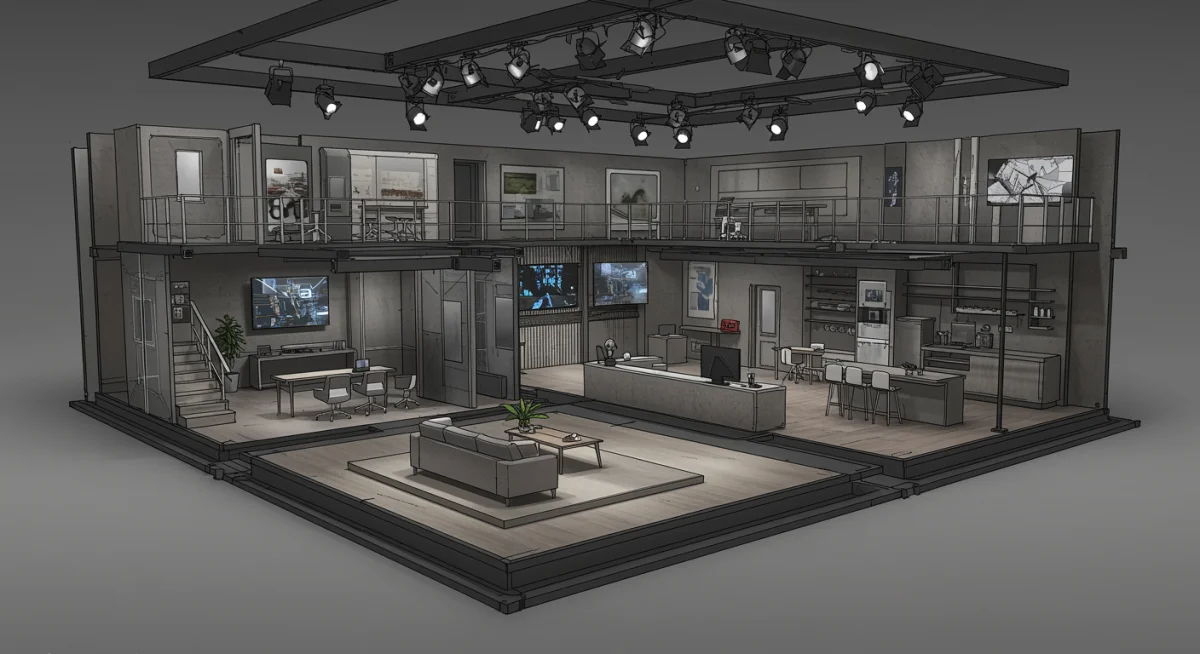Innovative Set Designs: Shaping US Drama in 2025

Six innovative set designs are poised to redefine US drama in 2025, integrating advanced technology and creative theatricality to deliver deeply immersive and compelling narrative experiences.
The landscape of US drama is constantly evolving, pushing boundaries not just in storytelling, but also in how those stories are presented. For those with insider knowledge: 6 innovative set designs shaping US drama in 2025 are already on the horizon, promising to transform the theatrical and cinematic experience. These designs are more than just backdrops; they are integral characters, enhancing narrative depth and audience immersion. What can we expect from these groundbreaking approaches?
The Rise of Dynamic and Interactive Environments
In 2025, set design is moving beyond static structures to embrace dynamic and interactive environments. This shift allows stages and screens to become fluid spaces that respond to the narrative, characters, and even audience input, blurring the lines between performance and reality. The goal is to create a living, breathing world that deeply engages viewers.
This evolution is fueled by advancements in projection mapping, LED technology, and motion sensors. Designers are no longer limited by physical constraints, but can create boundless worlds that change at a moment’s notice, reflecting psychological states or narrative shifts. The audience is transported, not just observing.
Projection Mapping and Augmented Reality Integration
Projection mapping, once a novelty, is now a cornerstone of innovative set design. By precisely mapping digital content onto complex physical surfaces, designers can create illusions of depth, movement, and transformation. When combined with augmented reality (AR) elements, the possibilities become truly limitless.
- Seamless World-Building: Projectors can instantly transform a barren stage into a bustling city street or a mystical forest, adapting to scene changes without physical reconstruction.
- Character Interaction: AR elements can allow characters to interact with virtual objects or environments, adding layers of fantasy or psychological depth to their performances.
- Audience Immersion: Some productions are exploring AR overlays for audience members, offering personalized perspectives or additional narrative insights through their devices.
The integration of these technologies ensures that every scene feels fresh and responsive. It allows for rapid transitions between vastly different settings, maintaining the narrative flow without interruption. This dynamic capability is a game-changer for dramatic storytelling.
Modular and Reconfigurable Structures
Efficiency meets artistry in the trend of modular and reconfigurable set designs. These innovative approaches allow for sets to be quickly dismantled, rearranged, and repurposed, maximizing versatility and minimizing waste. This is particularly valuable in productions with multiple locations or limited space.
Designers are utilizing lightweight, interlocking components and automated systems to achieve these transformations. The concept extends beyond mere practicality; it’s about creating a set that can evolve with the story, reflecting changes in theme or character development through its physical form.
Automated Set Changes and Robotics
Robotics and automation are playing a crucial role in bringing modular sets to life. Gone are the days of manual scene changes disrupting the flow of a performance. Automated systems ensure smooth, precise, and often breathtaking transitions.
- Rapid Scene Transformations: Robotic mechanisms can move large set pieces into place in seconds, allowing for fluid transitions between dramatically different environments.
- Dynamic Storytelling: Sets can reconfigure mid-scene, revealing hidden spaces or altering perspectives, thus actively participating in the narrative rather than just serving as a backdrop.
- Enhanced Safety and Precision: Automated systems reduce the risk of human error and ensure consistency in every performance, maintaining the artistic integrity of the design.
The ability to reconfigure sets with such ease opens up new avenues for dramatic storytelling, allowing for more complex narratives and visual metaphors to be explored. This flexibility is a key innovative set design trend for 2025.
Sustainable and Eco-Conscious Stagecraft
As environmental concerns grow, the drama industry is embracing sustainable and eco-conscious stagecraft. Innovative set designs in 2025 are prioritizing recycled materials, energy-efficient lighting, and designs that can be repurposed or biodegrade. This commitment reflects a broader societal shift towards environmental responsibility.
This approach isn’t just about reducing ecological footprint; it’s also about fostering creativity within constraints. Designers are finding ingenious ways to utilize reclaimed materials, transforming what was once waste into beautiful and functional set pieces. The result is often a unique aesthetic that tells its own story of resourcefulness.
Upcycling and Biodegradable Materials
The use of upcycled and biodegradable materials is becoming a hallmark of cutting-edge, responsible set design. This involves giving new life to discarded items and choosing materials that will naturally break down after use, minimizing landfill waste.
- Creative Reuse: Old shipping containers, salvaged wood, and industrial scraps are being transformed into striking architectural elements or functional props, each with its own history.
- Plant-Based Plastics: New bioplastics derived from cornstarch or other plant materials are being used for props and decorative elements, offering durability during production and biodegradability afterward.
- Local Sourcing: Prioritizing locally sourced materials reduces transportation emissions and supports regional economies, further enhancing the eco-friendly profile of a production.
The move towards sustainable materials is not only environmentally sound but also inspires a fresh aesthetic that often feels more authentic and grounded. It’s a powerful statement that art can be both impactful and responsible.

Immersive Soundscapes and Haptic Feedback
Beyond visual innovation, set design in 2025 is increasingly integrating immersive soundscapes and haptic feedback to create a truly multi-sensory experience. This extends the environment beyond what can be seen, drawing the audience deeper into the dramatic world through auditory and tactile sensations.
Sophisticated sound systems, often employing directional audio, can create the illusion of sounds originating from specific points on stage or even within the audience. When paired with haptic feedback technologies, which simulate touch and vibration, the impact is profound, making the audience feel physically present in the narrative.
Multi-Sensory Storytelling
Multi-sensory storytelling elevates the dramatic experience by engaging more than just sight and hearing. By incorporating haptic elements, designers can evoke physical responses that deepen emotional connection and narrative understanding.
- Directional Audio: Sounds of footsteps, whispers, or environmental noises can be precisely placed, making the audience feel like they are inside the scene rather than merely observing it.
- Vibrating Floors/Seats: Subtle vibrations can simulate earthquakes, explosions, or even the thumping of a character’s heart, adding a visceral layer to the drama.
- Environmental Effects: Beyond haptics, scent, and temperature changes can be subtly introduced to enhance realism, transporting the audience to different climates or settings.
This holistic approach to set design ensures that the audience’s entire sensory apparatus is engaged, creating a memory that is far richer and more impactful than traditional viewing. It’s a key element of the innovative set designs shaping US drama in 2025.
Integration of AI and Generative Design
Artificial intelligence (AI) is no longer just a buzzword; it’s becoming a practical tool in the arsenal of set designers. In 2025, AI and generative design are being used to create complex, evolving environments that can respond dynamically to live performances or audience interactions.
Generative design algorithms can explore thousands of design variations based on parameters set by the designer, optimizing for aesthetics, functionality, or even structural integrity. AI can also analyze scripts and character arcs to suggest environmental changes that enhance emotional impact, offering a new level of creative partnership.
AI-Powered Visual Effects and Adaptive Environments
The application of AI in visual effects allows for unprecedented levels of realism and adaptability. Environments can literally “think” and change in real-time, responding to the nuances of a live performance or the unfolding narrative.
- Real-Time Adaptation: AI can analyze actor movements and dialogue in real-time to trigger subtle changes in lighting, background projections, or even the movement of automated set pieces, creating a truly responsive environment.
- Generative Textures and Patterns: AI algorithms can create intricate and unique textures, patterns, and visual effects that are impossible to design manually, adding a layer of organic complexity to the set.
- Predictive Design: AI can assist in predicting how different design elements will impact audience perception and emotional response, allowing designers to fine-tune their creations for maximum effect.
This integration of AI marks a significant leap in set design, transforming static backdrops into intelligent, adaptive partners in storytelling. It’s a fascinating frontier that promises endless creative possibilities.
Minimalist Design with Maximalist Impact
Contrasting the technological maximalism, another innovative trend for 2025 is the mastery of minimalist design to achieve maximalist impact. This approach focuses on stripping away extraneous elements to highlight essential forms, textures, and lighting, allowing the narrative and performances to take center stage.
Minimalism isn’t about emptiness; it’s about intentionality. Every element on stage has a purpose, contributing to the overall aesthetic and emotional tone. This often involves clever use of negative space, shadow, and carefully chosen materials to evoke specific feelings or environments without literal representation.
Strategic Use of Light and Shadow
In minimalist sets, light and shadow become primary design elements. They sculpt the space, define boundaries, and create atmosphere with an economy of means. The absence of clutter allows these subtle shifts to have a profound effect.
- Emotional Illumination: Dynamic lighting can instantly shift the mood of a scene, from stark realism to dreamlike abstraction, guiding the audience’s emotional journey.
- Spatial Definition: Instead of physical walls, light and shadow can create invisible boundaries, suggesting rooms, corridors, or vast open spaces with simple projections or spotlights.
- Symbolic Representation: Shadows can be used to symbolize hidden truths, internal conflicts, or impending doom, adding layers of meaning without explicit set pieces.
This refined approach proves that sometimes, less is indeed more. By focusing on fundamental elements, minimalist designs create powerful, resonant spaces that allow the human drama to shine. These innovative set designs demonstrate a sophisticated understanding of visual storytelling.
| Key Design Trend | Brief Description |
|---|---|
| Dynamic Environments | Sets that transform and respond to narrative through projection mapping and AR. |
| Modular Structures | Reconfigurable sets using automation for versatile and rapid scene changes. |
| Sustainable Stagecraft | Eco-conscious designs using upcycled and biodegradable materials. |
| AI Integration | Generative design and real-time adaptive environments powered by artificial intelligence. |
Frequently Asked Questions About Innovative Set Designs
Projection mapping involves projecting digital imagery onto irregular surfaces to create illusions of changing environments, depth, and movement. It transforms static sets into dynamic visual landscapes, allowing for rapid scene changes and immersive visual storytelling without physical construction.
Modular sets offer versatility and efficiency, allowing sections to be quickly rearranged or repurposed for different scenes. This reduces construction time, labor costs, and material waste, while also providing dynamic environments that can evolve with the narrative and enhance visual interest.
Sustainable stagecraft addresses environmental concerns by using recycled, upcycled, and biodegradable materials, along with energy-efficient technologies. It minimizes waste and carbon footprint, aligning productions with global efforts towards ecological responsibility and inspiring creative solutions within ethical boundaries.
AI assists in generative design, exploring numerous aesthetic and functional variations. It also powers real-time adaptive environments that respond to live performances, adjusting lighting, projections, and set movements, thereby creating intelligent and highly responsive theatrical spaces that enhance narrative depth.
Immersive soundscapes use directional audio and advanced acoustics to make sounds appear to originate from specific points, drawing the audience deeper into the scene. When combined with haptic feedback, these multi-sensory elements create a more visceral and emotionally resonant experience, blurring the line between viewer and participant.
Conclusion
The innovative set designs poised to shape US drama in 2025 represent a thrilling evolution in storytelling. From dynamic, AI-powered environments to sustainable, minimalist masterpieces, these advancements are not merely decorative but are integral to crafting deeply immersive and emotionally resonant narratives. As technology continues to merge with artistic vision, the boundaries of what is possible on stage and screen will undoubtedly continue to expand, promising an exciting future for dramatic arts.





